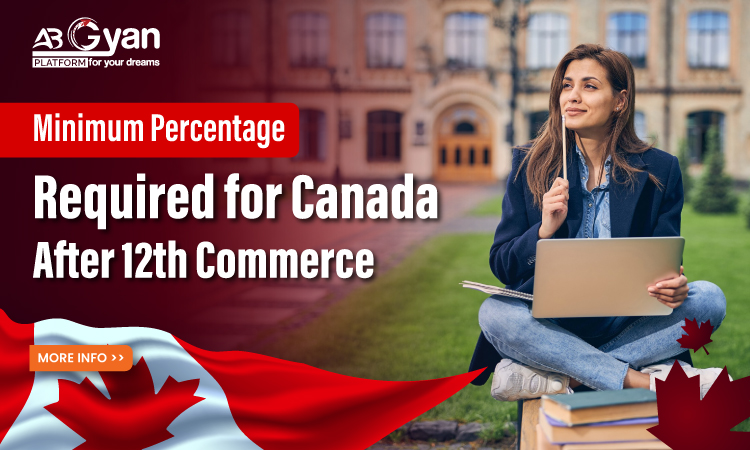
Minimum Percentage Required for Canada After 12th Commerce
Unlock Your Path to Canada: Know the Marks You Need After 12th Commerce!
Meet our Advisors Now
(Join between Mon to Sat 10:00 AM to 6:00 PM IST)
Minimum Percentage Required for Canada After 12th Commerce
- Bookmark
 Overview
Overview
Canada is known for its high-quality education, welcoming culture, and beautiful landscapes, it is no wonder so many international students choose Canada. If you have completed your 12th grade in Commerce and are considering studying there, understanding the minimum percentage required for admission can be a bit confusing. While the exact percentage needed can vary, being aware of Canadian student visa percentage requirements and preparing accordingly can help you achieve your goal of studying in Canada. This blog aims to simplify this for you, explaining what you need to know about percentage requirements for Canadian universities and colleges. Understanding how to Study in Canada After 12th is itself a daunting task. Study in Canada Consultants in Delhi can assist in understanding the minimum percentage required for Canada after a bachelor and guide you through the necessary steps. They can also help you explore various programs and universities based on your academic profile.
Overview of the Canadian Education System
Before diving into the specifics of percentage requirements, let’s start with a brief overview of the Canadian education system. In Canada, post-secondary education primarily comes in two forms:
Colleges: These institutions offer diploma and certificate programs, focusing on practical skills and applied learning.
Universities: These provide undergraduate and graduate degrees, offering a broader range of academic and professional programs.
Each type of institution has different admission requirements, so knowing how much percentage is required for Canada is essential for planning your education.
General Admission Requirements for Canadian Universities
To get into a Canadian university, you generally need to fulfil several requirements, which include:
Academic Records: This means your high school transcripts showing your grades.
Minimum Percentage or GPA: Each program and university will have a different requirement.
Standardized Tests: SAT or ACT.
Language Proficiency: You may need to prove your English skills with tests like IELTS or TOEFL.
Additional Documents: This can include letters of recommendation, personal statements, and sometimes interviews.
Minimum Percentage Requirements for Commerce Students
For students who have completed their 12th grade in Commerce, the percentage needed for admission to Canadian universities and colleges can vary. Here’s a straightforward guide:
Undergraduate Programs in Commerce and Business
Bachelor of Commerce (B.Com): This is a common program for students from a Commerce background. Most universities will ask for a minimum percentage between 60% and 75%. Here are some examples:
University of Toronto: Typically, you need at least 75% in your 12th grade. However, competitive programs might ask for higher percentages.
University of British Columbia (UBC): They usually require around 80%.
York University: Generally, a minimum of 70% to 75% is needed.
Bachelor of Business Administration (BBA): For BBA programs, the minimum percentage is similar to B.Com, ranging from 60% to 75%. For example:
Ryerson University: Usually requires around 70%.
University of Alberta: Generally, they need about 75% to 80%.
Accounting and Finance Programs
Bachelor of Accounting: Accounting programs are quite competitive, so the percentage required can be between 65% and 80%. For example:
University of Waterloo: Requires around 75% to 80%.
University of Calgary: Generally needs about 70% to 75%.
Bachelor of Finance: Similar to Accounting, Finance programs also have higher percentage requirements, typically between 70% and 80%. For instance:
University of Toronto Scarborough: Requires about 75% to 80%.
McGill University: Usually needs a minimum of 80% or higher.
Admission Requirements for Colleges
Colleges in Canada offer more hands-on, practical programs compared to universities. The minimum percentage required for colleges is generally lower than for universities:
Diploma Programs: For these, the required percentage is usually between 50% and 65%. For instance:
George Brown College: Typically requires around 60%.
Humber College: Generally needs about 55% to 60%.
Advanced Diploma Programs: These have similar requirements, often ranging from 55% to 65%. For example:
Seneca College: Usually needs a minimum of 60%.
Sheridan College: Generally requires about 55% to 60%.
You May Also Read:
UK Study Visa Requirements After 12th
Top Finance Universities In UK
UK Embassy Interview Questions And Answers For Student Visa
MBA In USA For Indian Students
Australian Study Visa Requirements
Factors Affecting Admission Requirements
Several factors can influence the percentage required for admission:
Program Popularity and Competitiveness: Programs that are very popular or in high demand may have higher percentage requirements. For example, Business and Finance programs at top universities might ask for higher percentages due to their competitive nature.
Admission Cut-offs: Each year, the cut-off percentage might change based on the number of applicants and their academic performance. It’s important to check the latest cut-offs on the university or college’s official website or contact their admissions office.
International Student Quotas: Some institutions have a specific number of spots for international students, which can affect the percentage requirements. Institutions may have different thresholds for international applicants compared to domestic ones.
What are the Tips to Improve Your Chances?
To increase your chances of meeting or exceeding the minimum percentage requirements, consider these tips:
Focus on Academics: Aim for high grades in your 12th grade to meet or exceed the minimum percentage.
Prepare for Standardized Tests: If your program requires tests like the SAT or ACT, prepare well to achieve high scores.
Enhance Your Application: Include strong letters of recommendation, a compelling personal statement, and highlight relevant extracurricular activities.
Improve Language Skills: Achieve high scores in English proficiency tests like IELTS or TOEFL to strengthen your application.
Research and Apply Strategically: Apply to a range of institutions with varying percentage requirements to increase your chances of acceptance.
How to Study in Canada After the 12th?
How to Study in Canada After the 12th can be an exciting yet challenging process. Here’s a quick guide:
Find Suitable Programs: Look for programs that match your interests and academic background.
Check Admission Requirements: Verify the percentage requirements and ensure you meet or exceed them.
Apply Early
Seek Guidance: Consider reaching out to Study in Canada Consultants who can provide personalized advice and support.
Secondly, how much percentage is required for Canada depends on the specific program and institution, but understanding these requirements will help you plan effectively.
Some General Queries of Students
Summing Up
Studying in Canada after completing your 12th grade in Commerce offers many opportunities for growth and development. Understanding the Canadian student visa percentage requirements for different programs and institutions is key to planning your education effectively. Canada’s diverse educational landscape provides a range of options to suit different academic backgrounds and career goals. By staying informed and proactive, you can enhance your chances of gaining admission to your desired program and embarking on a successful academic journey in Canada. For more personalized guidance, consider reaching out to Study in Canada Consultants.
Tags
LEAVE A REPLY
Related Blogs
For Queries, Feedback & Assistance
Contact AbGyan overseas Education Support
09:00 AM - 07:00 PM (IST)




 (1).webp)
.webp)





